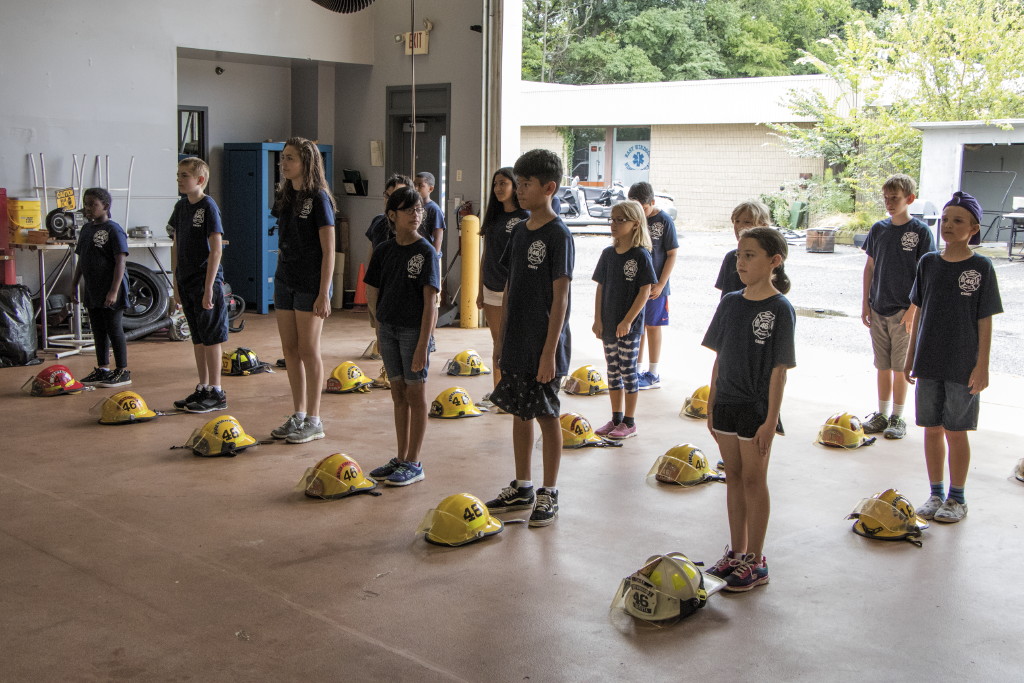The yellow fire truck, lights flashing and sirens blaring, pulled up to the curb and stopped.
The doors opened and several firefighters jumped out of the truck, rushed over to the fire hydrant, opened it and connected a hose.
The fire hose, however, stayed flat. No water was needed because there was no fire – just a demonstration by the young “firefighters” to show their parents what they had learned in East Windsor Volunteer Fire Co. No. 2’s week-long Youth Fire Academy.
The program, which ran from July 30 to Aug. 3, aimed to introduce young people to the world of firefighting and emergency services, Fire Chief Mario Batista said. This was the first time the camp had been offered in many years.
At the Youth Fire Academy, 18 youngsters between the ages of 10 and 15 learned what firefighters do. Police officers and emergency medical technicians visited the camp to tell the children what they do.
The campers also learned about 911 emergency communications through a visit by a representative from Mercer County Central Communications, which handles fire and EMS calls.
On a Saturday morning, the children were given a chance to show off their new skills at the East Windsor Volunteer Fire Co. No. 2 firehouse on Twin Rivers Drive.
Once they had simulated hooking up a hose between the fire truck and the fire hydrant, one of the “firefighters” raised a ladder against the firehouse. He climbed up a couple of rungs and then came down.
Batista explained that firefighters put ladders up against the four sides of a building so they can climb down them to escape the fire if they are on an upper floor and cannot walk down the steps.
Firefighters also put ladders up against a building so they can climb onto the roof. They may need to poke holes in the roof to let out hot gases, which are toxic.
The holes in the roof create a chimney effect, allowing the heat and smoke from a fire to escape, Batista said. Doing so clears the interior of the building, so firefighters can find the flames and put them out.
A firefighter never enters a burning building without wearing a mask and an air tank, known as a self-contained breathing apparatus (SCBA), Batista said. The tank holds enough oxygen to last about 45 minutes, but may be used up more quickly, depending on the firefighter’s physical condition.
If a firefighter is trying to put out a fire inside a building and the conditions worsen, he or she needs to get out. Sometimes, a firefighter has to knock a hole in the wall of one room to escape to an adjoining room. The campers showed how they would squeeze through that opening.
Perhaps the most important task a firefighter performs is to check the building for victims who may be trapped by the fire. Two young fire campers demonstrated search techniques – entering a room and crawling on the floor, keeping one hand in contact with the wall for orientation and the other hand reaching out for a possible victim.
If a firefighter or a victim is injured, the other firefighters have to pull out that person. The fire campers looped a rope around a “downed” firefighter, a dummy dressed in firefighter turnout gear, and pulled him to safety.
East Windsor Mayor Janice S. Mironov, who turned out for the end-of-camp demonstration, praised the volunteer firefighters who leave their jobs and families when they are summoned, because they care about the community.
Mironov also recognized the 18 youngsters who attended the Youth Fire Academy and who gained firsthand knowledge about some of the tasks and duties performed by firefighters.
“I know it was just a week, but I hear it was a packed week,” Mironov said, reminding the children they can take their new knowledge and skills with them.
Noah Schwartz was one of the 18 youngsters who signed up for the Youth Fire Academy. He said he was interested in attending a summer camp where he could learn something.
Noah, 13, who will be in the eighth grade at the Melvin H. Kreps Middle School, said he lives near the firehouse and has watched the fire trucks leave the building. He has also watched the volunteer firefighters when they drill.
Noah said he was most interested in the dispatching system. The dispatchers alert the firefighters about a fire and keep in constant contact with them. If a dispatcher makes a mistake, there could be serious consequences, Noah said.
Maddy Matamoros, 15, who also attended the Youth Fire Academy, was a little familiar with the fire department because her father, Milton Matamoros, is a volunteer firefighter with Hightstown Engine Co. No. 1.
“(The Youth Fire Academy) was an opportunity for me and my brother to learn more about firefighting. Initially, I had no desire to become a firefighter,” Maddy said. But as she learned more about what it is all about, she said she would like to become a volunteer firefighter.
“It is admirable for firefighters to risk their lives for everyday people they don’t even know,” said Maddy, who attends Hightstown High School.
In addition to Noah and Maddy, the Youth Fire Academy attendees included Kaitlyn Batista, Joshua Bosch, Zarabeth Bosch, Emily Dougherty, George Dougherty and Aniyah Douglas.
Also, siblings Dylan, Nicole and Olivia Gierman, Nathan Matamoros, Colin McCormick, Valeria Sandoval, siblings Milan and Rohan Shah, Anthony Supoy and Hector Torres.

